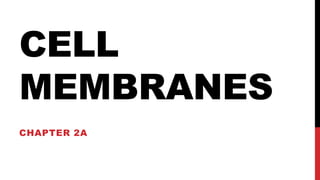
AS Biology - CELL MEMBRANES
- 4. LEARNING OBJECTIVES Know the structure and properties of cell membranes Understand how models such as the fluid mosaic model of membrane structure are interpretations of data used to develop scientific explanations of the structure and properties of cell membranes.
- 5. MEMBRANES All membranes act as barriers, controlling what passes through them and allowing the fluids either side of them to have different compositions.
- 6. FUNCTIONS OF MEMBRANES Some reactions of respiration occur in here (cristae) Contain enzymes for reactions Are flexible for shape change(WBC phagocytosis) Vesicles bind to membrane for releasing chemicals(neurotransmitters)
- 7. THE STRUCTURE OF MEMBRANES Two major components of all membranes are: 1. Phospholipids 2. Proteins
- 8. PHOSPHOLIPIDS Phospholipids are the most abundant lipid in the plasma membrane Phospholipids are amphipathic molecules, containing hydrophobic and hydrophilic regions The fluid mosaic model states that a membrane is a fluid structure with a “mosaic” of various proteins embedded in it
- 9. In a phospholipid, two fatty acids and a phosphate group are attached to glycerol The two fatty acid tails are hydrophobic, but the phosphate group and its attachments form a hydrophilic head
- 11. BILAYER FORMATION With water in each side phospholipids form a bilayer.
- 12. MEMBRANE MODELS In 1935, Hugh Davson and James Danielli proposed a sandwich model in which the phospholipid bilayer lies between two layers of globular proteins Later studies found problems with this model, particularly the placement of membrane proteins, which have hydrophilic and hydrophobic regions In 1972, J. Singer and G. Nicolson proposed that the membrane is a mosaic of proteins dispersed within the bilayer, with only the hydrophilic regions exposed to water
- 13. CONTROL OF MEMBRANE FLUIDITY
- 14. Cholesterol is a more rigid molecule than many of the phospholipids and so makes the membrane more stable and stronger.
- 15. MEMBRANE PROTEINS A membrane is a collage of different proteins embedded in the fluid matrix of the lipid bilayer Proteins determine most of the membrane’s specific functions
- 16. Two major groups proteins: 1. Integral proteins – channel, carrier proteins 2. Peripheral proteins are bound to the surface of the membrane
- 17. INTEGRAL PROTEINS Types of integral proteins are: 1. Gated channels 2. Channel proteins 3. Carrier proteins
- 18. MEMBRANE PROTEIN FUNCTIONS Six major functions of membrane proteins: • Transport • Enzymatic activity • Signal transduction • Cell-cell recognition • Intercellular joining • Attachment to the cytoskeleton and extracellular matrix (ECM)
- 20. BUILDING A MODEL OF THE MEMBRANE Charles Ernest Overton - In 1900, he proposed a biomembrane model "Overton Biomembrane Model" which stated that biomembranes are made up of lipids. Irving Langmuir – in 1917 demonstrated lipid monolayer. Evert Gorter and Francois Grendel – in 1925 used RBCs, proposed that lipid is bilayer. Davson and Danielli – in 1935, sandwich model.
